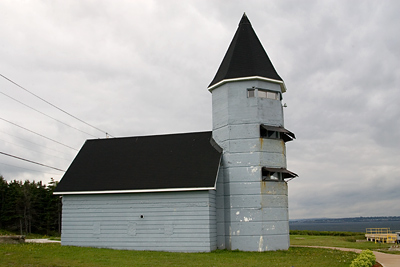Ken's Journal Baddeck, Nova Scotia |
| Baddeck is in the center of Cape Breton and is reasonbably convenient to everything I wanted to see. At the top of the list was the Cabot Trail, then the Fortress of Louisbourg and then some of the smaller museums. (Map here.) The weather was less than cooperative and for the first couple days, I was into the museums and other inside stuff. |
Baddeck in on the shore of the Bras D'Or Lake, a saltwater lake in the middle of Cape Breton. The lake is connected to the Atlantic on the north by a couple natural channels cut when the glaciers last covered the region. Bras D'Or, named by the French, the first explorers in the area, translates into "Arms of Gold." The lake is rather large at 424 square miles in area, 44 miles long, and up to 20 miles wide. This is the lighthouse on Kidston Island, sheltering the Baddeck harbor. |
As chance would have it, the week I picked to visit was the week of the Bras d'Or Yacht Club Regatta. Unfortunately for them, only a couple days were without rain - although the wind was pretty good to them! I saw more than one of the smaller sailboats capsized - either too much wind, too much enthusiasm or lack of experience on the part of the sailor.
|
In 1885, Alexander Graham Bell visited Baddeck for the first time. He enjoyed his visit so much. he spent much of the last 37 years of his life here at his Canadian home and estate. He called the 25 acre estate Beinn Breagh (Gaelic for 'beautiful mountain'). Here's a view from the front of the Alexander Graham Bell National Historic Site looking toward the Bras D'Or. This complex, with its three exhibit halls, contains the largest collection of Bell's artifacts and inventions, including replicas of the first telephones and a full scale model of the HD-4 hydrofoil craft. |
Here is a shot of his HD-4 hydrofoil - which in 1919 set the world marine speed record of 71 MPH. This craft is some 40 feet long and is powered by twin straight-8 engines driving a couple four-bladed props. You can see one of the hydrofoils at the lower left. There were three of these assemblies, two on the front and one on the rear (this is the front in case you were wondering). |
These display cases hold some of the Bell artifacts. There is a warehouse full of items Bell saved from his experiments and inventions - they periodically rotate through the display. |
This is an interpretive display of Bell's ideas on flight and the operation of a hydrofoil. |
The weather still wasn't cooperating so I made off for a couple more of the museums in the area. This is the Fort Petrie Military Museum near Sydney NS. (Map here.) This area was important to our effort during WWII as it was a major jumping off point for many of the supply convoys that left North America for Europe. Fort Petrie was built as a Coastal Defense Unit to protect Sydney Harbor and the convoys leaving the harbor, from the German Wolf Pack U-boats. This is the Observation Tower. |
This is the only shore battery remaining. |
Here's a view from the top floor of the Observation Tower towards one of the pads for a gun emplacement. The guns are long gone, but the concrete emplacements and the tunnel system connecting them and providing shelter for the troops is still existing. In disrepair, much of the tunnel system is off-limits today. Today, the Observation Tower is now a museum of sorts. It houses and displays a number of artifacts from the era. |
From the Observation Tower, I could see this lighthouse a few miles down the coast. I wandered a few roads until I found it. It's called Low Point Lighthouse and is operational as a navigational aid. |
"An American diplomat is sometimes like a bull who carries his own china shop around with him."
- Winston Churchill |
Page 23 |









